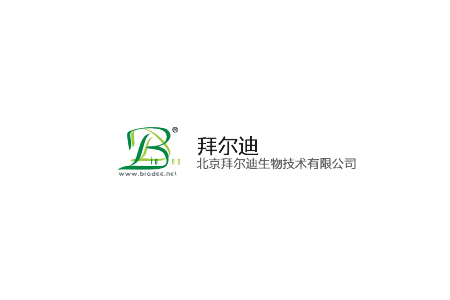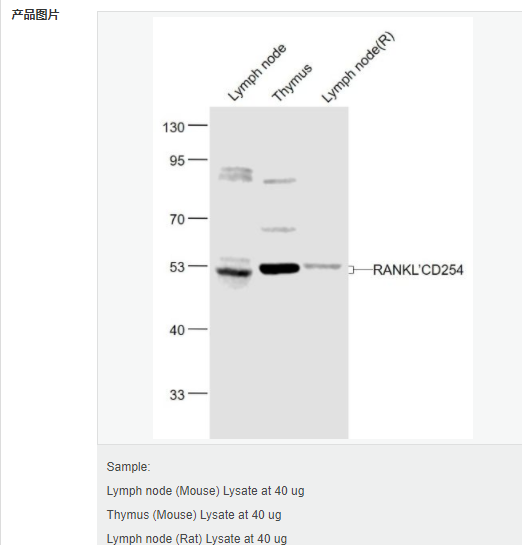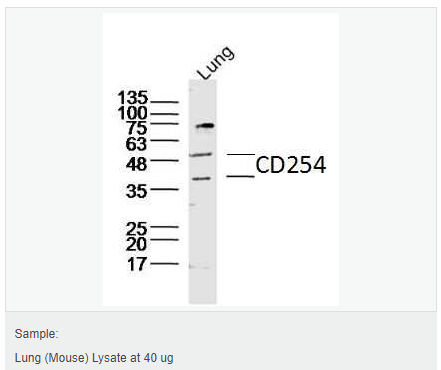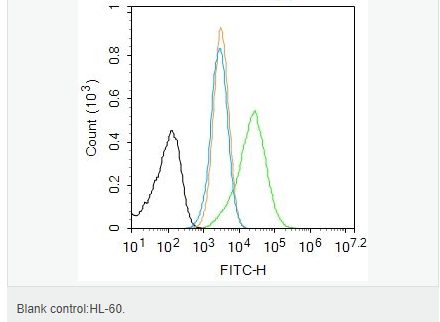

貨號
產品規格
售價
備注
BN40620R-100ul
100ul
¥2360.00
交叉反應:Rat,Mouse,Human(predicted:Zebrafish,Rabbit,Horse,Cow,Pig,Dog) 推薦應用:WB,Flow-Cyt
BN40620R-200ul
200ul
¥3490.00
交叉反應:Rat,Mouse,Human(predicted:Zebrafish,Rabbit,Horse,Cow,Pig,Dog) 推薦應用:WB,Flow-Cyt
產品描述
| 英文名稱 | RANKL/CD254 |
| 中文名稱 | 骨保護蛋白配體/破骨細胞分化因子抗體 |
| 別 名 | OPGL; CD254; hRANKL2; ODF; OPGL; Osteoclast differentiation factor; Osteoprotegerin ligand; RANKL; Receptor activator of nuclear factor kappa B ligand; sOdf; SOFA; TNF related activation induced cytokine; TNFSF 11; TNFSF11; TRANCE; Tumor necrosis factor ligand superfamily member 11; Osteoprotegerin Ligand; TNF11_HUMAN. |
| 研究領域 | 腫瘤 細胞生物 免疫學 發育生物學 |
| 抗體來源 | Rabbit |
| 克隆類型 | Polyclonal |
| 交叉反應 | Human, Mouse, Rat, (predicted: Dog, Pig, Cow, Horse, Rabbit, ) |
| 產品應用 | WB=1:500-2000 Flow-Cyt=1ug/Test not yet tested in other applications. optimal dilutions/concentrations should be determined by the end user. |
| 分 子 量 | 35kDa |
| 細胞定位 | 細胞漿 細胞膜 分泌型蛋白 |
| 性 狀 | Liquid |
| 濃 度 | 1mg/ml |
| 免 疫 原 | KLH conjugated synthetic peptide derived from human RANKL/CD254:41-140/317 |
| 亞 型 | IgG |
| 純化方法 | affinity purified by Protein A |
| 儲 存 液 | 0.01M TBS(pH7.4) with 1% BSA, 0.03% Proclin300 and 50% Glycerol. |
| 保存條件 | Shipped at 4℃. Store at -20 °C for one year. Avoid repeated freeze/thaw cycles. |
| PubMed | PubMed |
| 產品介紹 | This gene encodes a member of the tumor necrosis factor (TNF) cytokine family which is a ligand for osteoprotegerin and functions as a key factor for osteoclast differentiation and activation. This protein was shown to be a dentritic cell survival factor and is involved in the regulation of T cell-dependent immune response. T cell activation was reported to induce expression of this gene and lead to an increase of osteoclastogenesis and bone loss. This protein was shown to activate antiapoptotic kinase AKT/PKB through a signaling complex involving SRC kinase and tumor necrosis factor receptor-associated factor (TRAF) 6, which indicated this protein may have a role in the regulation of cell apoptosis. Targeted disruption of the related gene in mice led to severe osteopetrosis and a lack of osteoclasts. The deficient mice exhibited defects in early differentiation of T and B lymphocytes, and failed to form lobulo-alveolar mammary structures during pregnancy. Two alternatively spliced transcript variants have been found. [provided by RefSeq, Jul 2008]. Function: Cytokine that binds to TNFRSF11B/OPG and to TNFRSF11A/RANK. Osteoclast differentiation and activation factor. Augments the ability of dendritic cells to stimulate naive T-cell proliferation. May be an important regulator of interactions between T-cells and dendritic cells and may play a role in the regulation of the T-cell-dependent immune response. May also play an important role in enhanced bone-resorption in humoral hypercalcemia of malignancy. Subcellular Location: Cytoplasm; Secreted and Cell membrane. Tissue Specificity: Highest in the peripheral lymph nodes, weak in spleen, peripheral blood Leukocytes, bone marrow, heart, placenta, skeletal muscle, stomach and thyroid. Post-translational modifications: The soluble form of isoform 1 derives from the membrane form by proteolytic processing. The cleavage may be catalyzed by ADAM17. DISEASE: Defects in TNFSF11 are the cause of osteopetrosis autosomal recessive type 2 (OPTB2) [MIM:259710]; also known as osteoclast-poor osteopetrosis. Osteopetrosis is a rare genetic disease characterized by abnormally dense bone, due to defective resorption of immature bone. The disorder occurs in two forms: a severe autosomal recessive form occurring in utero, infancy, or childhood, and a benign autosomal dominant form occurring in adolescence or adulthood. Autosomal recessive osteopetrosis is usually associated with normal or elevated amount of non-functional osteoclasts. OPTB2 is characterized by paucity of osteoclasts, suggesting a molecular defect in osteoclast development. Similarity: Belongs to the tumor necrosis factor family. SWISS: O14788 Gene ID: 8600 Database links: Entrez Gene: 8600 Human Entrez Gene: 21943 Mouse Omim: 602642 Human SwissProt: O14788 Human SwissProt: O35235 Mouse Unigene: 333791 Human Unigene: 249221 Mouse Important Note: This product as supplied is intended for research use only, not for use in human, therapeutic or diagnostic applications. OPGL骨保護蛋白配體又稱骨保護素配體(破骨細胞發育刺激因子)。屬腫瘤壞死因子TNF-a家族。 OPGL促進破骨細胞的分化和活性,而OPG抑制這些過程。骨髓瘤細胞影響骨髓中這兩種蛋白的生理平衡,是發生溶骨性病變的根本所在。 |


